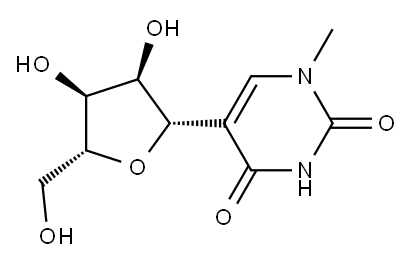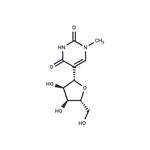N1-Methylpseudouridine is a modified nucleoside used for enhancing mRNA translation. Incorporation of N1-Methylpseudouridine into mRNA turns off the immune/eIF2α phosphorylation-dependent inhibition of translation, and increases ribosome pausing and density on the mRNA, thus dramatically facilitating the translation process. N1-Methylpseudouridine outperforms several other modified nucleosides (e.g. 5-Methylcytidine) and corresponding combinations in terms of translation capacity.
1-Methylpseudouridine is a substitute for uridine in modified mRNA. This substitution has shown to increase transfection by reducing immuogenicity. The 1-methylpseudouridine substituted mRNA increases protein expression due to low immune stimulation as it evades detection by the edosomal Toll-like receptor (TLR3).
ChEBI: 1-methylpseudouridine is a methylpseudouridine in which the methyl group is located at position N-1 on the uracil ring.
N1-methylpseudouridine (m1Ψ), the modification used in the current mRNA SARS-CoV-2 vaccines, was found to possess superior characteristics to Ψ; m1Ψ elicited less immunogenicity and increased protein production by more than an order of magnitude relative to Ψ m1Ψ preserves the fidelity of tRNA selection by the ribosome. Kim et al. explored the effect of m1Ψ and Ψ on decoding using various in vitro systems. They found that m1Ψ slightly decreases the rate of peptide-bond formation. It also suppresses near-stop codon recognition by release factors and m1Ψ-modified SARS-CoV-2 spike protein mRNA is translated faithfully by eukaryotic ribosomes. Unlike Ψ, m1Ψ does not stabilize mismatches during RNA-duplex formation. Ψ, but not m1Ψ, increases errors by reverse transcriptases[3].
N1-Methylpseudouridine is the methylated derivative of pseudouridine. It is used in in vitro transcription and for the production of RNA vaccines.In vertebrates, it stimulates significantly less activation of the innate immune response compared to uridine,while the translation is stronger.In protein biosynthesis, it is read like uridine and enables comparatively high protein yields.The nucleoside itself can be made by chemical methylation of pseudouridine.
1. Svitkin YV, Cheng YM, Chakraborty T, et al. N1-methyl-pseudouridine in mRNA enhances translation through eIF2α-dependent and independent mechanisms by increasing ribosome density. Nucleic Acids Research, 2017, 45(10): 6023-6036.
2. Andries O, Mc Cafferty S, De Smedt SC, et al N(1)-methylpseudouridine-incorporated mRNA outperforms pseudouridine-incorporated mRNA by providing enhanced protein expression and reduced immunogenicity in mammalian cell lines and mice. Journal of Controlled Release, 2015, 217: 337-344.
3. Kyusik Q Kim. “N1-methylpseudouridine found within COVID-19 mRNA vaccines produces faithful protein products.” Cell reports 40 9 (2022): 111300.



